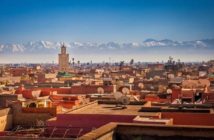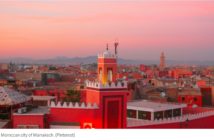Travel
After the heat and hassle of Marrakech, Oualidia’s oasis of calm soothes our writer with its long lagoon, seafood, royal surfers and pink flamingos
Net practice: fishermen on the beach at Oualidia, Morocco
Anna Stothard
The Observer
“Flamingos, surfers and royalty have discerning taste in beaches” – or so I’d been told by a Moroccan friend a few days previously, as we sat in the cloying Marrakech medina surrounded by the smells of spices and moped exhaust fumes.
She was exploring my beach options, to escape the city. “Agadir will steal your soul in return for cheap sunglasses,” she said, shooing away a man with a baby monkey on his shoulder asking for dirhams. “The wind in Essaouira turns people insane, but the lagoon of Oualidia is magic.” I’d heard of Agadir, of course, destination for Europeans seeking easy sun, and Essaouira, the seagull-wheeling hippy town where Orson Welles filmedOthello. But Oualidia?
No idea, yet the whispery syllables – pronounced wa-li-dee-ah – coupled with the intense midsummer heat of chaotic Marrakech, were enticement enough. “It’s where Marrakech goes to play and the Moroccan royal family learns to surf,” my friend smiled.
When we arrived, I thought perhaps there had been some mistake: it didn’t look like a town that would attract royalty. Or flamingos. But then you turn a corner towards the sea and Oualidia uncurls to reveal the magical lagoon at its centre.
It is immediately beguiling. The crescent of butterscotch-coloured sand loops at the southern tip of 11km of lagoon, protected from the crashing Atlantic by a barrier of rocks that catch all the violence of the ocean. Slickly wet-suited children surf in miniature waves and teenagers play football among djellaba-clad women making sandcastles with their babies on a stage-like central island, which evaporates and re-emerges with the tides. Over the course of our three days, it never looked like the same beach twice. Silver at night, the water was lilac in the rising morning.
In spring and autumn, migrating pink flamingos land here on the way from Spain to sub-Saharan Africa. We watched elegant sandpipers and curlews, herons marching their lolloping Egyptian walk through the sand, swallows dancing to the sound of minarets calling the boatmen, fisherman and surfers to prayer.
While most of the town is modern, hunched on the bluff above the water is a now-crumbling kasbah, built by the village’s namesake, Sultan El Oualid, in the 17th century. Below it is the ruin of Mohammed V’s summer palace, a skeleton of luminous yellow ochre fringed by fir and palm trees on the water’s edge. It has been abandoned for more than 50 years and guards hover on the rocks outside it, guns slung over their bodies, protecting the roofless staircases, dried-out swimming pools and Moorish arches.
“No photo, no,” shrugs a toothy fisherman outside the palace when I pull out my camera. Simultaneously, a nearby guard squares his shoulders and glares at me from under his hat, motioning me to turn away.
Friends of the present king – Mohammed VI, who has reigned since 1999 – apparently own villas in the area and when the local surf school teaches the royal children, the small lagoon fills up with a protective huddle of wet-suited bodyguards. Laurent Miramont, the handsome surf-school owner, insists the sheltered water means that anyone can learn to surf in Oualidia’s lagoon – he taught a 70-year-old to surf last week, a three-year-old a few weeks before that – but my stint on the waves proves him quite wrong. It seems I have no balance at all. Never mind, it was blissful out there – I idled away most of the afternoon sitting on my surfboard as if it were a sedan chair, watching the children fly over the enclosed puddle of ocean with the swelling, breaking waves.
The next morning I rode a white horse named Lagoon over the dramatic Atlantic beaches. If the calm inside the breakwater is too tame for your tastes, the surrounding shoreline is wild. At 9am, trotting through the surf as the mist cleared from the edges of jagged rocks, the only others along miles of sand were local children sitting by fishing poles or chasing each other in the water.
It takes a while, after the steaming intensity of Marrakech’s hard-sell, to realise nobody is going to hassle you in Oualidia. The kids don’t look up at you with their irresistible big brown eyes and ask for “Un dirham, s’il vous plaît?” and the men don’t stare at your ankles as if your bare flesh is both edible and immoral. Everyone just goes about their business. Passing the small fish market at the tip of the lagoon, in front of a battalion of blue fishing boats, fisherman will politely offer “Oursins? Ostreas?” But if you shake your head, they go back to talking among themselves.
Most of the voices on the beach were Arabic or French. I befriended Madhi, a musician from Safi playing football on the beach in his Oakley board shorts and “LA” baseball cap, who told me that he got the inspiration for all his songs from the landscape of Oualidia. Bashir, a well-travelled student at Cadi Ayyad University in Marrakech, on holiday with his parents, let me help him build an elaborate sandcastle with his five-year-old cousin. I asked him what there was to do in this town, and he laughed at me. “Just this,” he said, smiling. “Surf, sandcastles, eat fish and oysters. They say it’s Morocco’s St Tropez, but it’s not – it’s Oualidia, different from everywhere.”
You certainly wouldn’t come here for the boutique shopping or the choice of nightlife. In Marrakech we had sipped cocktails on the snakeskin window seats of new town lounge bars, swimming away hot days in the luxurious pool of Les Deux Tours Hotel before venturing out to haggle over the price of leather slippers and silver rings. In Oualidia, there are no beachside bars and only three restaurants of note, all of which serve nearly the same excellent food: fresh fish and huge wet oysters, which are a speciality of the region.
We visited L’Ostrea restaurant, which sits next to an oyster farm, in the evening and found it desolately empty until 10 o’clock, when elegant groups of French men and women began to drift onto the patio with stripy sweaters slung over their tanned shoulders, chain-smoking Marlboro reds between sips of white wine or slurps of giant oysters.
The other two restaurants are connected to Oualidia’s premier hotels, L’Hippocampe and La Sultana. We stayed at the former, owned by Latif Illane, whose cherry-red Alfa Romeo convertible sits outside the hotel and whose racing trophies decorate the fireplace underneath a grimacing wild boar head, which is affectionately referred to as “Lord Muchty”. Latif is rightfully proud of his lavish English-style garden, overgrown with dark red geraniums, nasturtiums, black-eyed Susans, daisies, arches of ivy and great fists of frilly pink hibiscus.
The rooms are simple and while the friendly staff speak French, you shouldn’t go there expecting to get by on English. There are larger suites at the front of the hotel, which walk straight out onto the veranda and the beach, and next time we visit I’ll book one of these. Built next to the ruined summer palace, L’Hippocampe’s location is unbeatable and we ate better in their restaurant than anywhere else in Morocco, fighting the sharp tangled limbs of giant spider crabs, sharing grilled soles, fresh off the boat that afternoon.
We ate seafood salad full of fresh calamari and mussels at the beachside restaurant of the more recent and decadent hotel, La Sultana, watching the more European clientele holidaying at this side of the lagoon – young English couples with well-dressed children, lanky French teenagers hiding behind Ray-Ban sunglasses. Certainly the atmosphere and service is more cosmopolitan, but after spending days watching epic football games, gaggles of surfers and industrious Moroccan sandcastle-makers on the beach, I felt a little sorry for the pretty English children in straw hats playing on their own outside La Sultana.
The most enjoyable activity in Oualidia isn’t swimming in La Sultana’s swanky infinity pool, surfing with Laurent and his beach-babies, or even birdwatching. My favourite moment of each Oualidia day was sitting on the beach as the sun began to fall, watching the football games turn to sunset silhouettes, the pleasure boats pausing their ferrying to bob on the tide, swallows chasing each other, men in billowing white kaftans standing with their toes in the waves as the sun finally disappears beyond the rocks. Even if you did nothing but sit on the beach for a week, the constantly shifting landscape would keep you entertained.
On our last day, sipping cold water under a straw umbrella as the sun turned the lagoon silver, we even saw the pale outline of flamingos flocking away in the distance. Quietly, we raised a toast to their spectacular taste in beach towns.
Anna Stothard’s novel, The Pink Hotel, is out now in paperback (Alma Books, £7.99)
Essentials
Anna Stothard’s trip was provided by Lawrence of Morocco (lawrenceofmorocco.com) which offers two nights at Les Deux Tours in Marrakech (with breakfast) and three nights at L’Hippocampe in Oualidia (half-board) including flights and transfers from £985pp. EasyJet (easyjet.com) flies to Marrakech from London Gatwick and Manchester from £82pp
.







